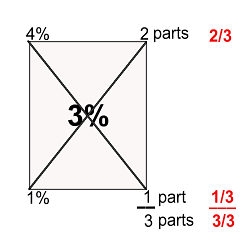Dairy Science
Method of determining remaining milk when taking off cream
Hi, Dairy Farmers/Processors
I get asked a lot how much milk remains after cream is taken off – hope this calculation helps. If I did it wrong – please let me know 🙂Theoretically:
1000 liters of milk(you start off with)40% fat in resulting cream(assume this is the fat % of your cream) Just substitute your cream’s tested fat % in here.
Problem 1:
What volume of milk remains when I take 3.8% butterfat milk down to 3.3%?(FULL CREAM)
3.8% – 3.3% = 0.5%
0.5% x 1000 liters = 500 parts of Fat removed
500 parts ÷ 40% cream = 12.5 Liters of cream
1000 – 12.5 = 987.5 liters milk remaining
Problem 2:
What volume of milk remains when I take 3.8% butterfat milk down to 2%?(LOW FAT)
3.8% – 2% = 1.8
1.8 x 1000 = 1800
1800 ÷ 40 = 45
1000 – 45 = 955 liters of milk remaining
Problem 3:
What volume of milk remains when I skim milk completely?
3.8% – 0% = 3.8%
3.8% x 1000 liters = 3800 parts of Fat removed
3800 parts ÷ 40% cream = 95 liters of cream
1000 – 95 = 905 liters of milk remaining
Kind regards,Leon the Milkman
Sampling from a milktank
Hi, Milk Scientists
When doing sampling from a milk tank to determine milk composotion, it is important that you sample from either the top or the bottom every time, even if you think that the milk was stirred enough – be consistent.
Also be aware that a round tank will probably only need 5 minutes of stirring, but a long/rectangular tank will need 10 minutes, because the milk do not build up momentum in those tanks.
Regards,
Leon the Milkman
Check this out:
Milk pH
Hi, Milkfans
The pH of milk should ideally be between 6.60 and 6.75.
When milk pH goes into the 6.5’s it is considered to be turning sour and above 6.80 there is reason to suspect mastitis(udder infection) or alkaline soaps – usually because of insufficient rinsing of tanks after cleaning.
Regards,
Leon the Milkman
How to use Pearson’s Square
Hi, Milk Scientists
Need to know how much milk to mix with another to get a certain butterfat %?
Use the Pearson Square or the “milk butterfat square”. Subtract diagonally and convert to the positive if not. Mix the parts as calculated and you will get the center value ( the one you wanted ).
In this example 2/3 of the final volume of the 4% milk must be added to 1/3 of the 1% milk to get 3% milk. So if you wanted 1000 L of 3% milk, then you would need 666 L of 4% milk and add that to 333 L of 1% milk.
This also works well for juices with different concentrations (Brix).
Kind regards,
Leon the Milkman
Remaining milk – calculation
Hi, Dairy Scientists
You start off with 3.8% butterfat and you skim off to 2% – what is the volume of milk remaining?
Let us say you started off with 1000 liters of milk and your resulting cream has a butterfat of 40%
3.8% – 2% = 1.8% difference per part
1.8% x 1000 liters = 1800 parts of fat to be removed
1800 ÷ 40% = 45 liters of cream
1000 liters – 45 liters = 955 liters of milk remaining.
Don’t ask me why or how – this is the way to do it – agreed?
Semi-convinced,
Leon the Milkman
Quick Casein Test
Hi, Cheese People
If you have a automated milk composition analyzer it would be possible to get a quick indication of casein by putting the milk through and then setting it with rennet. Take some of the whey and put it through the analyzer as well. Since the rennet binds the casein, by doing a subtraction of the whey protein from the whole milk, you should get the casein value.
Of course some of the more modern analyzers can do the casein automatically, anyway, but this method should help the other guys out there.
Regards,
Leon the Milkman
New CombiFoss
Hi, Milk People
This week I got my new Combifoss system. It will test for milk solids, added water and SCC.
Will tell you later if I could figure it out.
Kind regards,
Leon the Milkman
Define Psychrotrophic bacteria
Hi, Milkfans
These bacteria occur naturally in cold places like the Arctic.
They are important in frozen and refrigerated food where they can cause spoilage – even with the cold chain being maintained.
Examples are mould like Penicillium and bacteria like Pseudomonas, Bacillus and Clostridium.
They are an increasing problem in the dairy industry where the cold chain is maintained for longer periods on raw milk, than ever before in history.
Regards,
Leon the Milkman
Â
Judging Dairy
Â
Hi, Milkfans
I was a judge at the National Dairy Championships held by Agri-Expo in the Bellville Civic Centre, near Cape Town today. Thanks, Agri-Expo, it was fun as usual.
May the best products win!
Kind regards,
Leon the Milkman
P.S. check out this following link if you judge dairy as well.
Pseudomonas in Cottage Cheese
Hi, Cheesefans
Got a enquiry recently about why Pseudomonas bacteria love cottage cheese so much.
Well, I think it depends a lot on the flavour. 😉
Seriously Pseudomonas are widely distributed and aerobic. They tend not to use much carbohydrate ( lactose removed from cottage cheese ) and grow well in protein-rich foods (like cottage cheese) producing slime, pigments and some bad odours. They also prefer a high water activity ( high moisture content) and thus cottage cheese is pretty much ideal. Many are also psychrotrophic ( cold-loving ).
Although optimum temperatures are from 15 degrees Celsius to temperate – thus allowing the temperatures to go so high would speed up their growth exponentially.
Goodday to ya,
Leon the Milkman






